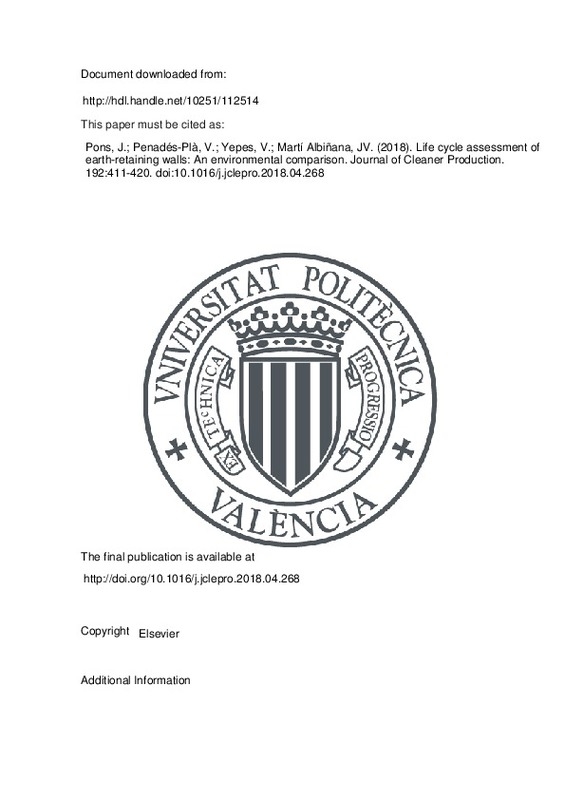JavaScript is disabled for your browser. Some features of this site may not work without it.
Buscar en RiuNet
Listar
Mi cuenta
Estadísticas
Ayuda RiuNet
Admin. UPV
Life cycle assessment of earth-retaining walls: An environmental comparison
Mostrar el registro sencillo del ítem
Ficheros en el ítem
| dc.contributor.author | Pons, J.J.
|
es_ES |
| dc.contributor.author | Penadés-Plà, Vicent
|
es_ES |
| dc.contributor.author | Yepes, V.
|
es_ES |
| dc.contributor.author | Martí Albiñana, José Vicente
|
es_ES |
| dc.date.accessioned | 2018-11-14T21:03:58Z | |
| dc.date.available | 2018-11-14T21:03:58Z | |
| dc.date.issued | 2018 | es_ES |
| dc.identifier.issn | 0959-6526 | es_ES |
| dc.identifier.uri | http://hdl.handle.net/10251/112514 | |
| dc.description.abstract | [EN] Earth-retaining walls are one of the most common structures in civil engineering, a discipline of the construction sector, which is known to produce one of the highest environmental impacts. Therefore, developing cleaner design and construction practices could contribute to a more sustainable future for our planet. To make a step towards this goal, this study comprises the life cycle assessment (LCA) of the four most common earth-retaining walls built between 1 to 6 m of height: cantilever walls, gravity walls, masonry walls and gabion walls to obtain the best solutions for the environment. To assess the environmental impacts caused throughout their whole life-cycle including the production, construction, use and end of life phases, we used the OpenLCA software, the ecoinvent 3.3 database and the ReCiPe (H) method. The associated uncertainties have been considered and the results are provided in both midpoint and endpoint approaches. Our findings show that gabion and masonry walls produce the lowest global impact. On the one hand, gabion walls cause less damage to human health but on the other hand, masonry walls cause less damage to the ecosystems. Furthermore, gravity walls produce similar impacts to gabion and masonry walls between 1 and 3 m of height as well as fewer impacts than cantilever walls for a height of 4 m. In conclusion, gabion and masonry walls are preferable to concrete walls for heights between 1 and 6 m and cantilever walls should be used over gravity walls for greater heights than 4.5 m. | es_ES |
| dc.description.sponsorship | This research was funded by the Spanish Ministry of Economy and Competitiveness along with FEDER funding (Project BIA2017-85098-R). | |
| dc.language | Inglés | es_ES |
| dc.publisher | Elsevier | es_ES |
| dc.relation.ispartof | Journal of Cleaner Production | es_ES |
| dc.rights | Reconocimiento - No comercial - Sin obra derivada (by-nc-nd) | es_ES |
| dc.subject | Life cycle assessment | es_ES |
| dc.subject | Sustainability | es_ES |
| dc.subject | Earth-retaining wall | es_ES |
| dc.subject | ReCiPe | es_ES |
| dc.subject.classification | INGENIERIA DE LA CONSTRUCCION | es_ES |
| dc.title | Life cycle assessment of earth-retaining walls: An environmental comparison | es_ES |
| dc.type | Artículo | es_ES |
| dc.identifier.doi | 10.1016/j.jclepro.2018.04.268 | es_ES |
| dc.relation.projectID | info:eu-repo/grantAgreement/AEI/Plan Estatal de Investigación Científica y Técnica y de Innovación 2013-2016/BIA2017-85098-R/ES/DISEÑO Y MANTENIMIENTO OPTIMO ROBUSTO Y BASADO EN FIABILIDAD DE PUENTES E INFRAESTRUCTURAS VIARIAS DE ALTA EFICIENCIA SOCIAL Y MEDIOAMBIENTAL BAJO PRESUPUESTOS RESTRICTIVOS/ | es_ES |
| dc.rights.accessRights | Abierto | es_ES |
| dc.contributor.affiliation | Universitat Politècnica de València. Instituto de Ciencia y Tecnología del Hormigón - Institut de Ciència i Tecnologia del Formigó | es_ES |
| dc.contributor.affiliation | Universitat Politècnica de València. Departamento de Ingeniería de la Construcción y de Proyectos de Ingeniería Civil - Departament d'Enginyeria de la Construcció i de Projectes d'Enginyeria Civil | es_ES |
| dc.description.bibliographicCitation | Pons, J.; Penadés-Plà, V.; Yepes, V.; Martí Albiñana, JV. (2018). Life cycle assessment of earth-retaining walls: An environmental comparison. Journal of Cleaner Production. 192:411-420. doi:10.1016/j.jclepro.2018.04.268 | es_ES |
| dc.description.accrualMethod | S | es_ES |
| dc.relation.publisherversion | http://doi.org/10.1016/j.jclepro.2018.04.268 | es_ES |
| dc.description.upvformatpinicio | 411 | es_ES |
| dc.description.upvformatpfin | 420 | es_ES |
| dc.type.version | info:eu-repo/semantics/publishedVersion | es_ES |
| dc.description.volume | 192 | es_ES |
| dc.relation.pasarela | S\363969 | es_ES |
| dc.contributor.funder | Agencia Estatal de Investigación | es_ES |







![[Cerrado]](/themes/UPV/images/candado.png)

